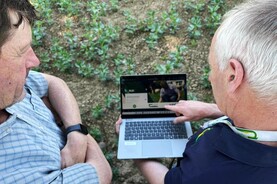For those farmers expecting an alternative income stream from carbon farming, the Teagasc Counting Carbon event in Ashtown last week didn’t inspire much confidence.
The message was that it needs to be clearly measurable, and verification is crucial. While there is a lot of good work ongoing both inside and outside of Teagasc in terms of measuring carbon changes, you get the feeling that the baseline carbon stocks in soils is and will be harder to quantify.
Trade-off
There seems to be a trade-off happening on the actual cost of doing this (carbon sampling every field) relative to the value of the carbon that might be traded or established.
The French example used showed relatively small value changes in carbon, but thankfully, they used net emissions, with much of the upside for the French farmers coming from the carbon dioxide equivalent displacement of fossil fuels used on the farms.
This was similar to the ARCZero project in Northern Ireland. With Northern Ireland and (I’m led to believe) Wales initiating field by field carbon measurement, you would have to wonder if this is where we should be going for credible quantification and a baseline which seems so crucial?
Poor growth could lead to feed shortage
It is clear as we approach the end of June that feed stocks are going to be limited for the coming winter.
The reduction in the use of artificial nitrogen, without the replacement value of clover in the swards, has led to a significant reduction in grass growth on many productive farms.
We have known for years that if you don’t harvest surplus winter feed in May and June, it is very hard to make up the deficit.
Again, it is absolutely critical that we re-establish and re-engage the feed and fodder stakeholder committee and keep it part of an ongoing measure, not this sporadic crisis-to-crisis gather up. If the Department doesn’t want to do this, then the industry should.
For those farmers expecting an alternative income stream from carbon farming, the Teagasc Counting Carbon event in Ashtown last week didn’t inspire much confidence.
The message was that it needs to be clearly measurable, and verification is crucial. While there is a lot of good work ongoing both inside and outside of Teagasc in terms of measuring carbon changes, you get the feeling that the baseline carbon stocks in soils is and will be harder to quantify.
Trade-off
There seems to be a trade-off happening on the actual cost of doing this (carbon sampling every field) relative to the value of the carbon that might be traded or established.
The French example used showed relatively small value changes in carbon, but thankfully, they used net emissions, with much of the upside for the French farmers coming from the carbon dioxide equivalent displacement of fossil fuels used on the farms.
This was similar to the ARCZero project in Northern Ireland. With Northern Ireland and (I’m led to believe) Wales initiating field by field carbon measurement, you would have to wonder if this is where we should be going for credible quantification and a baseline which seems so crucial?
Poor growth could lead to feed shortage
It is clear as we approach the end of June that feed stocks are going to be limited for the coming winter.
The reduction in the use of artificial nitrogen, without the replacement value of clover in the swards, has led to a significant reduction in grass growth on many productive farms.
We have known for years that if you don’t harvest surplus winter feed in May and June, it is very hard to make up the deficit.
Again, it is absolutely critical that we re-establish and re-engage the feed and fodder stakeholder committee and keep it part of an ongoing measure, not this sporadic crisis-to-crisis gather up. If the Department doesn’t want to do this, then the industry should.






 This is a subscriber-only article
This is a subscriber-only article










SHARING OPTIONS: